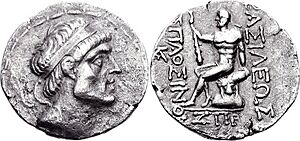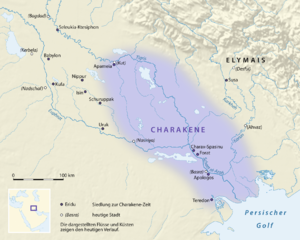Hyspaosines facts for kids
Quick facts for kids Hyspaosines |
|
|---|---|

Coin of Hyspaosines as King, minted at Charax Spasinu in 126/5 BC
|
|
| King of Characene | |
| Reign | c. 141–124 BC |
| Successor | Apodakos |
| King of Babylon | |
| Reign | 127 BC |
| Predecessor | Artabanus I |
| Successor | Artabanus I |
| Born | c. 209 BC |
| Died | 11 June 124 BC (aged 85) |
| Spouse | Thalassia |
| Father | Sagdodonacus |
Hyspaosines (also called Aspasine) was the founder of Characene. This was a kingdom located in southern Mesopotamia. He was first a governor for the Seleucid Empire. King Antiochus IV Epiphanes (who ruled from 175 to 164 BC) put him in charge.
But in 141 BC, the Seleucid Empire became weak. The Parthian Empire took over many areas. So, Hyspaosines decided his kingdom would be independent. In 127 BC, Hyspaosines briefly took control of the city of Babylon. Old records call him "king" there. By 124 BC, he had to accept that the Parthians were more powerful. He died that same year. His young son, Apodakos, became king after him.
Who Was Hyspaosines?
Hyspaosines came from Iranian families. His name is a Greek version of an old Persian or Bactrian name. It might mean "who appreciates all things." His father, Sagdodonacus, likely had a Bactrian name too. This suggests he was from Bactria.
Sagdodonacus worked for local rulers in Persis. These rulers had been independent from the Seleucid Empire for about 30 years. They even briefly took over the Characene area. Later, the Seleucid ruler Antiochus IV Epiphanes took back control. He made his general, Noumenios, the governor of Characene.
Becoming a Governor

The main city of Characene was Alexandria. Alexander the Great first built this city. He wanted it to be a major trading port for his eastern capital, Babylon. But the city did not become as important as he hoped. Floods destroyed it in the mid-3rd century BC.
King Antiochus IV Epiphanes rebuilt the city. He renamed it Antiochia. After it was fully restored in 166/5 BC, Antiochus IV made Hyspaosines the governor of Antiochia and the surrounding lands.
During this time, Antiochia grew for a while. But Antiochus IV died unexpectedly in 163 BC. This made the Seleucid Empire weaker. Many parts of the empire then declared independence. One of these was Elymais, a neighboring region. Even though Hyspaosines was now mostly independent, he stayed loyal to the Seleucids. He likely wanted to keep the profitable trade going between Antiochia and Seleucia.
Hyspaosines as King
The Seleucids suffered big defeats from the Parthian Empire. In 148/7 BC, the Parthian king Mithridates I (who ruled from 171 to 132 BC) conquered Media and Atropatene. By 141 BC, he also controlled Babylonia. These events are written in ancient Babylonian records.
The Parthians were a growing threat. Because they were so close, Hyspaosines declared his independence. In 127 BC, Mithridates I's son, Phraates II, died suddenly. He was fighting nomads in the east. Hyspaosines used this chance to take over Babylon. Babylonian records confirm this, calling him "king" there.
His rule over Babylon was short. In early November 127 BC, the Parthian general Timarchus took the city back. Even so, Hyspaosines' troops continued to raid the Babylonian region until 126 BC.
In 124 BC, Hyspaosines accepted that the Parthians were his overlords. He continued to rule Characene as their vassal. He even sent a message to the Parthian general in Babylonia. He told him that the Parthian king Mithridates II (who ruled from 124 to 91 BC) had defeated Elymais. Hyspaosines also returned a special wooden throne to the Parthians. It was a gift for the god Bel.
Ancient records say that Hyspaosines became sick on June 3, 124 BC. He died on June 11, 124 BC, at the age of 85. A Roman historian named Lucian wrote about rulers who lived to be very old. Hyspaosines was on his list.
His young son, Apodakos, became king after him. Apodakos's mother was Queen Thalassia. The Parthian commander Sindates was then made the governor of Characene.

